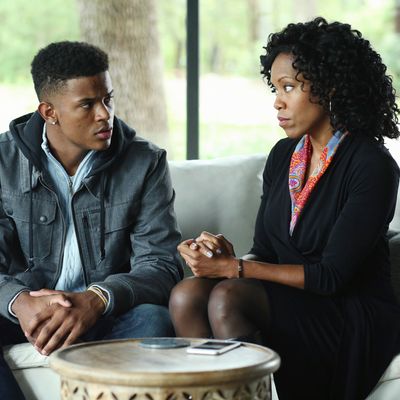
John Ridley’s American Crime, which begins its second season tonight, is another of the new anthology series in which a recurring cast plays different characters, and the unit of measure is the season rather than the episode. But unlike its gridmates True Detective, American Horror Story, and Fargo, it has no easy-to-peg genre hook, unless you consider the kind of storytelling that the film scholar David Bordwell dubbed a “network narrative” to be a genre unto itself. Like most cinematic examples of the form, American Crime gives us several ongoing, subtly interlaced but essentially parallel stories, in which unsuspecting average citizens’ lives are bound together by a seismic event. Here, it’s a brutal but depressingly typical crime (a drug-related murder and sexual assault in season one; a possible roofie-rape of a male basketball player attending a private high school in season two); in other examples, it could be a love affair (Spike Lee’s Jungle Fever), a political assassination (Robert Altman’s Nashville), or simply the experience of living in a particular community or dealing with a particular institution (see pretty much any documentary by Frederick Wiseman).
American Crime is much more deliberately (or you might say slowly) paced than its forebears, and largely devoid of humor. It’s written, directed, and acted in an unadorned, at times punishingly austere style that sometimes lets entire scenes play out in one long take while focusing on a single character and letting others (including some leads) remain out of focus or offscreen. Other times we see characters wading into some of the most intense arguments of their lives while the camera observes them from across the street or from the other side of an apartment, until finally it cuts to a very tight close-up that lets the heart of the scene play out through an actor’s face or, occasionally, their hand gestures. It’s all so dour and intense that I could only take three or four episodes of the first season before needing a breather, but when I caught up with the rest of season one, near the end of last year, I was acclimated. It is, to use a friend’s formulation, a show that teaches you how to watch it, and by the harrowing finale — a portrait of mostly broken but infrequently redeemed lives — I was entranced by it. It’s a pebble in the shoe of quality television: It changes your mental gait and forces you to adapt, and while it never lets you get comfortable, after a while you might somewhat masochistically appreciate its determination to tell its story in its own way.
Ridley, who adapted the Oscar-winning 12 Years a Slave and oversees American Crime, has a lot of issues on his mind, but the show never feels entirely issue-driven. Season one dealt with, in no particular order, racism, xenophobia, secular versus religious mind-sets, class bias, the incompetence of the criminal-justice system, the socially destructive effects of the War on Drugs, and the ways in which prison tends to breed criminals rather than show them the error of their ways. Season two deals with all of these issues, plus the tribal mentality that pits blacks and Hispanics and blacks and whites against each other within the same school, or the same community, and the coach of a winning basketball team (Timothy Hutton, in a kind of pervy Tom Hanks mode) against the headmistress (Felicity Huffman) who’s trying to be sensitive to the pain of a young player (Connor Jessup) who says he was sexually assaulted by teammates. The boy’s mother (Lily Taylor) wants justice for her son but keeps slamming against the concrete wall of bureaucratic self-protection. Season two is not much more of a laugh riot than season one (not that it should be; the show’s mode is the show’s mode), but it’s much more varied in its rhythms, letting basketball games, student parties, and family gatherings play out in a jumble of Friday Night Lights–style, quasi-documentary quick-cut montages, and saving its ominously stationary or slowly gliding camera movement for scenes of intense claustrophobia and frustration.
I wrote recently that second seasons are often more important to a show’s development than freshman ones, because they let the filmmakers and actors stretch their creative legs, refine bits that worked and discard ones that didn’t, and generally settle into whatever the show might eventually become. I haven’t watched all of season two of American Crime — only the first three episodes were sent out to reviewers — but what I’ve seen makes me believe in the show as a confident and controlled artistic achievement rather than an assortment of great notions. Besides Hutton, Taylor, and Huffman, the returning cast includes the incomparable Regina King as the mother of another high-school basketball star; Elvis Nolasco, who in season one played a scruffy and despairing accused murderer locked in a mutually destructive relationship with a white fellow drug addict (Caitlin Gerard), returns here as the principal of a public high school whose students and teachers resent the privilege of Huffman’s insulated private academy. There are heated school-board meetings, private “justice” inquests, and many scenes exploring the role of mobile devices in everyday interaction; scene for scene, it feels more attuned to the daily realities of life in 2016 America than any other drama on network TV. And because it’s a self-contained story that bears no relation to season one, you can jump right into it. I urge you to give it a shot if you aren’t already a fan. Just be patient. It’s one of those shows that needs a bit of time to work its peculiar magic.





